DESTINATIONS (TOURIST SITES)
YANGON
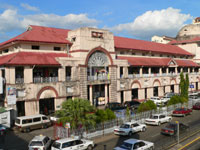 Scott Market (YANGON) Yangon (Literally meaning End-of -Strife) is the capital of Myanmar as well as the gateway to Myanmar. It lies 34 km upriver from the Gulf of Mottama (Mataban). It is a gracious once-colonial city, laid out in a conventional “colonial grid” pattern resembling a chessboard, planned by the British city planners.
Scott Market (YANGON) Yangon (Literally meaning End-of -Strife) is the capital of Myanmar as well as the gateway to Myanmar. It lies 34 km upriver from the Gulf of Mottama (Mataban). It is a gracious once-colonial city, laid out in a conventional “colonial grid” pattern resembling a chessboard, planned by the British city planners.
Yangon is proud of the towering gold-crusted Shwedagon Pagoda, which is best known for its grandeur and awe-inspiring greatness. Described by Rudyard Kipling (1898) as “a beautiful, winking wonder that blazed in the sun, of a shape that was neither Muslim dome nor Hindu temple spire,” Shwedagon Pagoda is the one of the most magnificent monuments on earth. It is said to have been built over 2,500 years ago and Four Relics of the FOUR BUDDHAS are enshrined in it. The Pagoda is covered with 60 tons of pure gold and Its Umbrella or Tip is set with diamonds, rubies, sapphires and emeralds. Other places of interest are the Sule Pagoda, the Kaba Aye (World Peace) Pagoda, Chauk-Htat-gyi Pagoda, National Museum, Bogyoke Aung San (Scott) Market, and Colonial Buildings.
Many old colonial style buildings are still standing in YANGON, many of which are now occupied by government offices. The City Hall is one of the grandest, an impressive stone structure with classical colonial style and integrated with a Myanmar touch. The Supreme Court, High Court, General Post Office, Strand Hotel, Port Authority Building, Custom House and Railway Administrative Building are also magnificent remembrances of the bygone era.
East of Yangon…..
THANLYIN (Syriam) & KYAUKTAN
 If you spare half day in Yangon, you can make excursion to both Thanlyin and Kyauktan across the Yangon (Hlaing) River. Thanlyin (formerly known as Syriam) was the ancient capital of the Mon Kings. In olden days around late 16th century, it was a principal seaport and was once occupied by the notorious Portuguese adventurer called Philip De Brito. There is a tomb supposed to house the remains of De Brito in the compound of present day oil refinery. Kyaik Khauk Pagoda here is a popular place of pilgrimage.
If you spare half day in Yangon, you can make excursion to both Thanlyin and Kyauktan across the Yangon (Hlaing) River. Thanlyin (formerly known as Syriam) was the ancient capital of the Mon Kings. In olden days around late 16th century, it was a principal seaport and was once occupied by the notorious Portuguese adventurer called Philip De Brito. There is a tomb supposed to house the remains of De Brito in the compound of present day oil refinery. Kyaik Khauk Pagoda here is a popular place of pilgrimage.
Continuing 15 km further south of Thanlyin, you’ll reach Kyauktan, which is famous for its Kyaik-hmaw-wun mid-stream Pagoda (a Pagoda located on a tiny island in the mid-river). There are many Sampans (a small powered-boat) at riverbank ferry to the islet shrine. Perhaps you may amuse yourself by short riding of Sampan for a few kyat.
West of Yangon…..
TWANTE
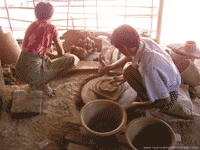 Twante is famous for its Shwe Sandaw Pagoda, pottery and cotton-weaving. Exploring the town by charter-trishaw will definitely give you a new experience and amusement. 1 or 2 km further south of local market is the pottery workshop where you can observe their traditional way of process. You can get Twante by crossing the Yangon River by ferry and proceed by public jeep, taking approx. one and a half hour. Another version, much slower but provides a glimpse of life on and along the famous Twante Canal, is to take ferry all the way down to Twante, approx. three and a half hours journey.
Twante is famous for its Shwe Sandaw Pagoda, pottery and cotton-weaving. Exploring the town by charter-trishaw will definitely give you a new experience and amusement. 1 or 2 km further south of local market is the pottery workshop where you can observe their traditional way of process. You can get Twante by crossing the Yangon River by ferry and proceed by public jeep, taking approx. one and a half hour. Another version, much slower but provides a glimpse of life on and along the famous Twante Canal, is to take ferry all the way down to Twante, approx. three and a half hours journey.
North of Yangon…..
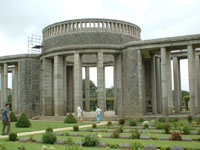 Htaukkyant is a small junction town where the road forks off to Pyay and Bagan to the north-west and to Bago and Mandalay to the north-east. Here you can visit a tree shrine dedicated to a legendary “Nat” to witness some local peoples’ belief and Allied War Graves Cemetery with 27,000 graves of allied soldiers who died in Myanmar and Assam campaigns of WWII. It is beautifully maintained by the Commonwealth War Graves Commission.
Htaukkyant is a small junction town where the road forks off to Pyay and Bagan to the north-west and to Bago and Mandalay to the north-east. Here you can visit a tree shrine dedicated to a legendary “Nat” to witness some local peoples’ belief and Allied War Graves Cemetery with 27,000 graves of allied soldiers who died in Myanmar and Assam campaigns of WWII. It is beautifully maintained by the Commonwealth War Graves Commission.
BAGO (Pegu)
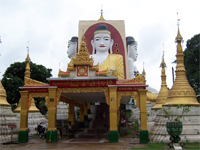 Bago was the ancient capital of Mon kings and also the capital of second Myanmar Empire founded by warrior King Bayin Naung. It is said that during his reign, Myanmar Kingdom encompassed the areas of what is now CHAING MAI and parts of northern THAILAND and LAOS. It is situated only about 80 km, in the north, from Yangon, and far enough to avoid tourists. The interesting sites are the Shwe-maw-daw Pagoda (Its spire is even taller than the Great Shwedagon Pagoda), Shwe-tha-lyaung (Great Reclining Image of Buddha), Kalyani Thein (Ancient Ordination Hall for monk hood), the four gigantic Buddha images of Kyaik-pun Pagoda, and the Reconstructed Kamboza-thadi Palace of King Bayin Naung.
Bago was the ancient capital of Mon kings and also the capital of second Myanmar Empire founded by warrior King Bayin Naung. It is said that during his reign, Myanmar Kingdom encompassed the areas of what is now CHAING MAI and parts of northern THAILAND and LAOS. It is situated only about 80 km, in the north, from Yangon, and far enough to avoid tourists. The interesting sites are the Shwe-maw-daw Pagoda (Its spire is even taller than the Great Shwedagon Pagoda), Shwe-tha-lyaung (Great Reclining Image of Buddha), Kalyani Thein (Ancient Ordination Hall for monk hood), the four gigantic Buddha images of Kyaik-pun Pagoda, and the Reconstructed Kamboza-thadi Palace of King Bayin Naung.
KYAIKHTIYO (Golden Rock)
 KYAIKHTIYO PAGODA, known as “Golden Rock,” perches on the edge of a cliff at the top of Kyaikhto mountains range, part of the Eastern Yoma. This magnificent “Golden Rock” is the most meditative and popular tourist attraction in Mon State. A small Stupa rests on top of a big boulder covered in gold leaf, which balances on the cliff thanks to a Sacred Hair of the Buddha enshrined or preserved inside the Stupa.
KYAIKHTIYO PAGODA, known as “Golden Rock,” perches on the edge of a cliff at the top of Kyaikhto mountains range, part of the Eastern Yoma. This magnificent “Golden Rock” is the most meditative and popular tourist attraction in Mon State. A small Stupa rests on top of a big boulder covered in gold leaf, which balances on the cliff thanks to a Sacred Hair of the Buddha enshrined or preserved inside the Stupa.
KYAIKHTIYO is 160 km from YANGON and is an important place of pilgrimage for all Buddhists. It can be reached either by car or by train. Devotees usually climb uphill about 13 km on foot from the base-camp. There is a well-beaten path up to the top of the mountain from the base-camp called Kinpun. However, a motor road has been built recently up to the next camp called Yathetaung (about 45-minute drive), from where it takes another 45-minute to walk up. All the tiredness along the way disappears once one reaches the top since a spectacular view awaits there, especially at sunrise or sunset. It is said that on a clear day one can see the ANDAMAN SEA glistening in the distance.
MAWLAMYINE (MOULMEIN)
Mawlamyaing is the capital and port of the Mon State. It lies at the mouth of Thanlwin (Salween) river about 39 km upstream from the Gawdwin Lighthouse. It is situated at 270 km south-east of Yangon. Many old colonial buildings still remain along the quiet streets. Several fine Pagodas and Monasteries up in the hills above MAWLAMYINE give you the perfect views of the city and its harbour.
MANDALAY
 Mandalay was the last capital of the third Myanmar Empire. It is located 668 km north from Yangon. Mandalay’s value lies in that it is a repository of late Myanmar history. Mandalay embodies all the elements of Myanmar’s ancient educational, social and cultural system. Mandalay is the home and guardian of the best traditions of Myanmar music and dance .The Mandalayans preserves the proper spoken language of Myanmar. Symbols of religion are richer in Mandalay than in any of the living Myanmar city. It is the principal centre for studies of Buddhist literature. The other tourist attractions are Mandalay Hill, Mya-nan-san-kyaw Golden Palace, the old city walls and the moat; Mahamuni Image of Buddha, which is the most revered and sacred site of Mandalay; Kyauk-taw-gyi Buddha, white Marble huge seated image of the Buddha carved from a single block of stone; Kuthodaw Pagoda with the entire Buddhist scriptures inscribed on 729 marble slabs, known as the “World’s Biggest Book”; Shwenandaw Kyaung (Golden Palace Monastery), a superb example of a traditional Myanmar wooden monastery.
Mandalay was the last capital of the third Myanmar Empire. It is located 668 km north from Yangon. Mandalay’s value lies in that it is a repository of late Myanmar history. Mandalay embodies all the elements of Myanmar’s ancient educational, social and cultural system. Mandalay is the home and guardian of the best traditions of Myanmar music and dance .The Mandalayans preserves the proper spoken language of Myanmar. Symbols of religion are richer in Mandalay than in any of the living Myanmar city. It is the principal centre for studies of Buddhist literature. The other tourist attractions are Mandalay Hill, Mya-nan-san-kyaw Golden Palace, the old city walls and the moat; Mahamuni Image of Buddha, which is the most revered and sacred site of Mandalay; Kyauk-taw-gyi Buddha, white Marble huge seated image of the Buddha carved from a single block of stone; Kuthodaw Pagoda with the entire Buddhist scriptures inscribed on 729 marble slabs, known as the “World’s Biggest Book”; Shwenandaw Kyaung (Golden Palace Monastery), a superb example of a traditional Myanmar wooden monastery.
One account states that during the reign of King Mindon, steamers began to come up to INNWA (AVA) and AMARAPURA. Since both towns were on the bank of the AYEYARWADDY (IRRAWADDY) RIVER, it would have been possible for the Europeans to bring artillery pieces up-river aboard the trading ships and to shell the then capital of AMARAPURA. King Mindon therefore decided that the capital should be moved some distance from the river, beyond the range of enemy fire. This must have been the original reason of founding MANDALAY though there were some other reasons.
ANCIENT CITIES AROUND MANDALAY
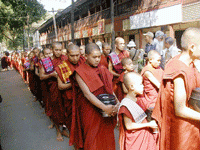 Amarapura (literally meaning ‘the immortal city’) lies about 11 km south of Mandalay. The modern town of AMARAPURA is often referred to as Taung Myo, meaning “The Southern City” to distinguish it from MANDALAY, the Northern City. Around 1795 Amarapura was the site for the first British embassy in Myanmar. The famous U Pein Bridge built with teak posts spans Taungthaman Lake. It measures 1208 meters and probably is the longest bridge of its kind in South East Asia. Other places of interest include Pahtodawgyi Pagoda, Kyauktawgyi Pagoda and Mahagandayon Monastery, home to over thousand monks renowned as a centre for Buddhistic study and strict religious discipline.
Amarapura (literally meaning ‘the immortal city’) lies about 11 km south of Mandalay. The modern town of AMARAPURA is often referred to as Taung Myo, meaning “The Southern City” to distinguish it from MANDALAY, the Northern City. Around 1795 Amarapura was the site for the first British embassy in Myanmar. The famous U Pein Bridge built with teak posts spans Taungthaman Lake. It measures 1208 meters and probably is the longest bridge of its kind in South East Asia. Other places of interest include Pahtodawgyi Pagoda, Kyauktawgyi Pagoda and Mahagandayon Monastery, home to over thousand monks renowned as a centre for Buddhistic study and strict religious discipline.
INNWA
Innwa, a former capital of upper Myanmar (Literally meaning Mouth of the Lake) for nearly 400 years after the fall of Bagan, is situated only 30-minute drive south of MANDALAY. At one time Myanmar was known in the west as the KINGDOM OF AVA and its power was said to be extended as far as Pyay (Prome). Though the Royal Palace has gone, the Pagodas, Temples and Monasteries still remain. Of particular interest are the brick monastery called MAHA AUNG MYAY BONZAN, built by Queen Me Nu and NANMYINT watchtower, which gives a birds’ eye view of the ancient site.
SAGAING
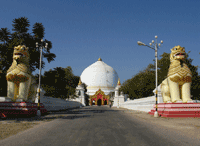 Located at 21 km southwest of Mandalay, Sagaing had also been the capital of central Myanmar. However it fell to the Shan people around 1315 and became the capital of an Independent Shan Kingdom. There are plenty of Pagodas and over 600 monasteries and nunneries Dotted along the Sagaing Hills. Most date from the turn of 19th century and are built in a fascinating mix of colonial and old Myanmar style. Nowadays, the Sagaing Hills is noted as a religious retreat for Myanmar Buddhist devotees. About 10 km north from Sagaing stands KAUNGMUDAW, an enormous dome-shaped pagoda built by King Thalun in 1636. Nearby lies Ywahtaung village, which is well known for its silver craftsmanship.
Located at 21 km southwest of Mandalay, Sagaing had also been the capital of central Myanmar. However it fell to the Shan people around 1315 and became the capital of an Independent Shan Kingdom. There are plenty of Pagodas and over 600 monasteries and nunneries Dotted along the Sagaing Hills. Most date from the turn of 19th century and are built in a fascinating mix of colonial and old Myanmar style. Nowadays, the Sagaing Hills is noted as a religious retreat for Myanmar Buddhist devotees. About 10 km north from Sagaing stands KAUNGMUDAW, an enormous dome-shaped pagoda built by King Thalun in 1636. Nearby lies Ywahtaung village, which is well known for its silver craftsmanship.
MINGUN
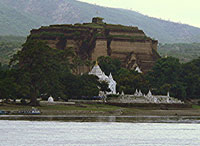 About 11 km trip up-river from MANDALAY on the opposite bank of the AYEYARWADDY River is the pleasant and peaceful MINGUN VILLAGE. This 45 minute memorable journey gives visitors a fascinating experience of life along the river. It is home to the 90 tons weigh World’s Biggest RINGING Bell as well as the World’s Largest but Unfinished Pagoda. History has it that if King Bodaw Phaya had succeeded in his great plan; this Pagoda might now have been the World’s Largest Pagoda. Unfortunately, King Bodaw Phaya died around 1819 before the construction was completed, and leaving it as a huge brick base that stands about a third of its intended height.
About 11 km trip up-river from MANDALAY on the opposite bank of the AYEYARWADDY River is the pleasant and peaceful MINGUN VILLAGE. This 45 minute memorable journey gives visitors a fascinating experience of life along the river. It is home to the 90 tons weigh World’s Biggest RINGING Bell as well as the World’s Largest but Unfinished Pagoda. History has it that if King Bodaw Phaya had succeeded in his great plan; this Pagoda might now have been the World’s Largest Pagoda. Unfortunately, King Bodaw Phaya died around 1819 before the construction was completed, and leaving it as a huge brick base that stands about a third of its intended height.
East of Mandalay…..
PYIN OO LWIN (Maymyo)
 PYIN OO LWIN (formerly called Maymyo) is the one of the most famous hill station cities of Myanmar. Its fine, pleasant weather and fresh cool air makes it a popular summer resort. It was a British hill station where, during the hot season, the servants of the Raj went to escape the heat and dust of the plains. It enjoys another name given affectionately by the local – PAN MYO DAW, or Royal Flower City due to its variety of colourful flowers growing in abundance all over the town. This beautiful resort is situated only 70 km east of MANDALAY, and at about 1070m above sea level. Dotted around the town are half-timbered Tudor style cottages surrounded by well-kept gardens. Since the place is full of visitors all year round several of these cottages have now been converted into hotels. Some of the highlights are the PWE KAUK or B.E. Waterfall, the DAT TAW GYAIK Waterfall, the famous Botanical Garden and the Chinese Temple. Being rich in natural scenic spots, PYIN OO LWIN is the favourite place for nature lovers, photographers, artists, and moviemakers. Besides, it is also junction leading to the China border towns of LASHIO and MUSE.
PYIN OO LWIN (formerly called Maymyo) is the one of the most famous hill station cities of Myanmar. Its fine, pleasant weather and fresh cool air makes it a popular summer resort. It was a British hill station where, during the hot season, the servants of the Raj went to escape the heat and dust of the plains. It enjoys another name given affectionately by the local – PAN MYO DAW, or Royal Flower City due to its variety of colourful flowers growing in abundance all over the town. This beautiful resort is situated only 70 km east of MANDALAY, and at about 1070m above sea level. Dotted around the town are half-timbered Tudor style cottages surrounded by well-kept gardens. Since the place is full of visitors all year round several of these cottages have now been converted into hotels. Some of the highlights are the PWE KAUK or B.E. Waterfall, the DAT TAW GYAIK Waterfall, the famous Botanical Garden and the Chinese Temple. Being rich in natural scenic spots, PYIN OO LWIN is the favourite place for nature lovers, photographers, artists, and moviemakers. Besides, it is also junction leading to the China border towns of LASHIO and MUSE.
North-west of Mandalay…..
MONYWA
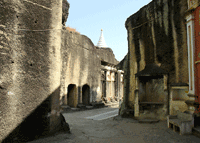 Situated some 136 km northwest of MANDALAY, MONYWA is the center of the CHINDWIN VALLEY. Being the second largest river of Myanmar, CHINDWIN is now important for agricultural trading in the area, especially beans, pulses, cotton, flour and edible oils. History has it that MONYWA was founded in the BAGAN Era (1044-1287) and it was formerly called “THALARWADDY”. It is noted for its unusually Temples. One of the most famous is THANBODDHAY TEMPLE, which is vaguely reminiscent of INDONESIA’S BOROBUDUR because of similarities in its architectural design. KYAUKKA VILLAGE, some 16 km east of MONYWA, is also famous for its lacquer ware cottage industry since the Konbaung era. Its lacquer wares are said to be linked to the Siamese styles that existed before the Bagan artisans. Another highlight of MONYWA is the crater lake of TWIN HILL. According to geologists, it was the crater of an extinct volcano some five million years ago. But another version said that it was the effect of a meteorite, and rainfall subsequently filled the crater to form a lake. Whatever the source, there is now an algae processing plants there which became the only site in Myanmar for spirulina produces. If you across the Chindwin River by short ferry, followed by a 25km drive will reach PHO WIN TAUNG, impressive sandstone caves contain Buddha Statues, wood carvings and murals dating back 14th to 16th centuries. Just beyond Pho Win Taung is SHWEBA TAUNG, which features unique pavilions cut out of the surrounding sandstone to house Buddha Images.
Situated some 136 km northwest of MANDALAY, MONYWA is the center of the CHINDWIN VALLEY. Being the second largest river of Myanmar, CHINDWIN is now important for agricultural trading in the area, especially beans, pulses, cotton, flour and edible oils. History has it that MONYWA was founded in the BAGAN Era (1044-1287) and it was formerly called “THALARWADDY”. It is noted for its unusually Temples. One of the most famous is THANBODDHAY TEMPLE, which is vaguely reminiscent of INDONESIA’S BOROBUDUR because of similarities in its architectural design. KYAUKKA VILLAGE, some 16 km east of MONYWA, is also famous for its lacquer ware cottage industry since the Konbaung era. Its lacquer wares are said to be linked to the Siamese styles that existed before the Bagan artisans. Another highlight of MONYWA is the crater lake of TWIN HILL. According to geologists, it was the crater of an extinct volcano some five million years ago. But another version said that it was the effect of a meteorite, and rainfall subsequently filled the crater to form a lake. Whatever the source, there is now an algae processing plants there which became the only site in Myanmar for spirulina produces. If you across the Chindwin River by short ferry, followed by a 25km drive will reach PHO WIN TAUNG, impressive sandstone caves contain Buddha Statues, wood carvings and murals dating back 14th to 16th centuries. Just beyond Pho Win Taung is SHWEBA TAUNG, which features unique pavilions cut out of the surrounding sandstone to house Buddha Images.
NORTHERN SHAN STATE
North-east of Mandalay…..
KYAUKME
Kyaukme is a small market town located on the motor road as well as rail routes between Mandalay and Lashio which is the main China-Myanmar trade. The highlights of this town are the bustling market and some colonial-era buildings adjacent to the market.
THIBAW (Hsipaw)
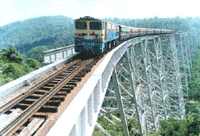 Thibaw (formerly known as Hsipaw), once the centre of a Shan State, is a small, peaceful with relaxed atmosphere. This small town is situated between Mandalay and Lashio. Its residents are mostly Shan and the town itself is rather unsophisticated and enjoys moderate climate. Thibaw is small enough to roam about on foot, and most of the travelers who are not in a hurry like to its simple and ambience atmosphere. As the place gradually becomes a popular hangout amongst the foreign travelers, the numbers of lodgings are now increased as well.
Thibaw (formerly known as Hsipaw), once the centre of a Shan State, is a small, peaceful with relaxed atmosphere. This small town is situated between Mandalay and Lashio. Its residents are mostly Shan and the town itself is rather unsophisticated and enjoys moderate climate. Thibaw is small enough to roam about on foot, and most of the travelers who are not in a hurry like to its simple and ambience atmosphere. As the place gradually becomes a popular hangout amongst the foreign travelers, the numbers of lodgings are now increased as well.
LASHIO
It is located 200 km south of China border at the southern end of infamous Burma Road. Nowadays the town is getting more and more occupied by many a Chinese and thus you can easily see Chinese influence in town. Lashio is in a mountain basin at about 855m above sea level and divided into two main districts – Lahio Lay (Little Lashio) and Lashio Gyi (Big Lashio). There are some pagodas and a hot spa for foreigners to visit. The railroad between Lashio, Thibaw and Kyaukme and Mandalay is quite fascinating since the train passes over the GOKHTEIK viaduct which is said to be the world’s second largest steel bridge of more than a hundred years old. This was built by the American in the British Raj and is considered to be the greatest railway viaduct in the world at the time.
ARCHAEOLOGICAL ZONE
BAGAN (Pagan)
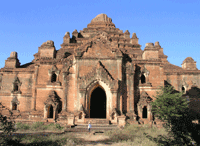 Bagan was ancient capital of the first Myanmar Empire, founded by King Anawrahta. What is more, Anawrahta accomplished another great task for the country: he introduced Theravada Buddhism into Myanmar with the help of Shin Arahan, a mission monk from THATON. It is one of the richest archaeological sites in Southeast Asia. Bagan preserves 2217 well-renovated Stupas (Buddhist religious monuments) according to the most contemporary references, however, these figures do not count brick mounds, which would totalize nearly 4000 separate visible sites. Pagodas and Temples represent the diversity of ancient Myanmar architectural styles in the 11th to13th centuries. Intricate frescoes or mural paintings depicting the life of Buddha decorate the interiors of the Pagodas and Stupas. Bagan has so many mesmerizing scenes that impress one’s memory forever.
Bagan was ancient capital of the first Myanmar Empire, founded by King Anawrahta. What is more, Anawrahta accomplished another great task for the country: he introduced Theravada Buddhism into Myanmar with the help of Shin Arahan, a mission monk from THATON. It is one of the richest archaeological sites in Southeast Asia. Bagan preserves 2217 well-renovated Stupas (Buddhist religious monuments) according to the most contemporary references, however, these figures do not count brick mounds, which would totalize nearly 4000 separate visible sites. Pagodas and Temples represent the diversity of ancient Myanmar architectural styles in the 11th to13th centuries. Intricate frescoes or mural paintings depicting the life of Buddha decorate the interiors of the Pagodas and Stupas. Bagan has so many mesmerizing scenes that impress one’s memory forever.
At BAGAN all monuments are NOT the same. All are highly original in design and conception. The structural techniques, similar to the gothic form of Western Cathedral architecture, were in advance of contemporary engineering in Europe. Technologically daring in notion, and exquisite in execution, the Temples of BAGAN are of a splendor rarely witnessed anywhere else in the world.
South-east of Bagan…..
MT POPA
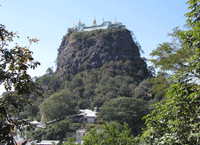 Mount Popa, located 67km southeast of Bagan, is the core of an extinct volcano. However the centerpiece of this is a solitary peak (known as Popa Taung Kalat in Myanmar) rising 737m abruptly from the surrounding flat plain. This is the sacred home of what is known as NATS (spirits) – a collection of 37 magical spirits both feared and honoured by some Myanmar people. They still believe that nats can make life difficult if they are not accorded sufficient respect. Thousands of Myanmar gathers here twice yearly to honour the spirits and attend the festivals (May/June). Mount Popa is so lush and green that it is called the Oasis of the Dry Zone. Mt. Popa is established as the National Park for medicinal herbs, sandalwood plantation and reforestation projects. It can be visited on a day trip from BAGAN or as a brief stop en route to MANDALAY.
Mount Popa, located 67km southeast of Bagan, is the core of an extinct volcano. However the centerpiece of this is a solitary peak (known as Popa Taung Kalat in Myanmar) rising 737m abruptly from the surrounding flat plain. This is the sacred home of what is known as NATS (spirits) – a collection of 37 magical spirits both feared and honoured by some Myanmar people. They still believe that nats can make life difficult if they are not accorded sufficient respect. Thousands of Myanmar gathers here twice yearly to honour the spirits and attend the festivals (May/June). Mount Popa is so lush and green that it is called the Oasis of the Dry Zone. Mt. Popa is established as the National Park for medicinal herbs, sandalwood plantation and reforestation projects. It can be visited on a day trip from BAGAN or as a brief stop en route to MANDALAY.
MEIKHTILA
Meikhtila, an important and prosperous trade centre, is the junction town where travelers can be bound for Bagan or Taunggyi (Lake Inle) or continue straight to Mandalay. Even though there are not much particular interesting sites here in Meikhtila one can savor the atmosphere of a busy mid-sizes town, and far enough to avoid tourists at the same time.
South of Bagan…..
SALAY
Salay is located 36km south of Bagan. During the late Bagan era, to be more accurate, the late 12th and 13th century, Salay grown as the expanding spiral of Bagan’s influence gradually moved south-ward along the Ayeyarwaddy River. Salay was the home of famous writer and poet of Bagan era called “Salay U Ponya” whose works are still studied and referred by many modern Myanmar scholars. Several old two-storey colonial buildings in town reveal the evidence of British’s establishment here. Among the monuments of Salay, the major places of interest are NAN PAYA (also known as Mann Paya), perhaps the largest lacquer Buddha image in Myanmar dating back to the 13th century, and YOKE-SONE-KYAUNG, the oldest surviving wooden monastery bearing more than 120-year-old original sculptures of 19th century court life, Jatakas (stories from the Buddha’s life) and Ramayana tales (one of Asia’s best know legends), and the collections of antique religious objects from the area.
North-west of Bagan…..
PAKOKKU
Pakokku is a tobacco trading town of the area in addition to its famous checked blankets made from cotton, and thanakha (the outer bark of the Linoria acidissima tree used as a combination skin conditioner, sunscreen and cosmetic for Myanmar women). Travelers can get there after crossing the Ayerwaddy River from Nyaung U (Bagan), either by river or more commonly by private car from Mandalay. Even though the town itself has little to offer, a further 20km northwest of Pakokku reach you to the remains of PAKHANGYI which is a 19th century town with old city walls, an archaeological museum and one of the oldest surviving wooden monasteries in upper Myanmar.
NORTH-EASTERN MYANMAR
SOUTHERN SHAN STATE
THAZI
Even though Thazi is in Mandalay division, it is just located 65km west of the Shan State border and thus beginning or ending point of Shan territory. In addition it is the Yangon-Mandalay train line intersects with Bagan and Taunggyi lines. So Thazi is a small town where travelers embark or disembark from train to travel to/from Bagan or Taunggyi (Lake Inle).
KALAW
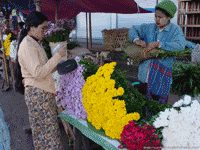 Kalaw is located about 71 km west of Taunggyi, just about half-way along the Thazi-Taunggyi road. It is a peaceful and quiet summer resort nestled in pine-clad Shan Plateau. Being at an altitude of 1320m, Kalaw is pleasantly cool all-year-round and ideal place for trekking to interesting hill-tribes living in the surrounding mountains of Kalaw. These hill-tribes in their colourful costumes coming to Kalaw market add to the tranquil lure of Kalaw.
Kalaw is located about 71 km west of Taunggyi, just about half-way along the Thazi-Taunggyi road. It is a peaceful and quiet summer resort nestled in pine-clad Shan Plateau. Being at an altitude of 1320m, Kalaw is pleasantly cool all-year-round and ideal place for trekking to interesting hill-tribes living in the surrounding mountains of Kalaw. These hill-tribes in their colourful costumes coming to Kalaw market add to the tranquil lure of Kalaw.
PINDAYA
 Pindaya is a small picturesque town, situated about 45km north of Kalaw. The journey from junction road AUNG PAN to PINDAYA is breathtaking in many ways with panoramic mountain views; said to be resembled the southern parts of Italy. Pindaya is noted for its natural limestone Caves housing over 8,000 Buddha Images of various sizes, made from teak, lacquer, marble, alabaster and cement, and an picturesque Bouketaloke lake surrounded by shady giant Banyan trees. On market days, one can find different races residing in the region gathered at the market, buying and selling the products of the area. It is also possible to trek to surrounding Danu, Palaung, Pa-O and Taungyo villages.
Pindaya is a small picturesque town, situated about 45km north of Kalaw. The journey from junction road AUNG PAN to PINDAYA is breathtaking in many ways with panoramic mountain views; said to be resembled the southern parts of Italy. Pindaya is noted for its natural limestone Caves housing over 8,000 Buddha Images of various sizes, made from teak, lacquer, marble, alabaster and cement, and an picturesque Bouketaloke lake surrounded by shady giant Banyan trees. On market days, one can find different races residing in the region gathered at the market, buying and selling the products of the area. It is also possible to trek to surrounding Danu, Palaung, Pa-O and Taungyo villages.
INLE LAKE
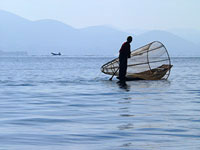 One of the most picturesque spots in Myanmar, probably in Southeast Asia, Inle Lake sprawls at about 30km south of Taunggyi. This vast picturesque lake with its mesmerizing beauty is situated roughly 1000m above sea level and surrounded by hazy Blue Mountains. In fact INLE LAKE and surrounding region is an outstanding alternative to the historical sites of BAGAN and MANDALAY. It is best known for its villages built on stilts over the surface of the Lake and gardens on floating islands created from mud and reed. Innthas (native lake-dwellers thought to have migrated from Southern Myanmar) glide about on the lake in their boats, propelled by one leg rowing. Although the unique leg-rowers are the most famous attraction in the region, there’s more. Some highlights of INLE are PHAUNG DAW OO PAGODA (home to five Buddha Images, said to have brought back to Myanmar from southern Thailand over 700 years ago), the 200-year-old wooden NGA PHE KYAUNG MONASTERY (a place to see the lovely “Jumping Cats”), and YWAMA VILLAGE (formerly floating market site). As the only mode of transportation is boat and motorboat, Inle is figuratively named the “Venice of the East”
One of the most picturesque spots in Myanmar, probably in Southeast Asia, Inle Lake sprawls at about 30km south of Taunggyi. This vast picturesque lake with its mesmerizing beauty is situated roughly 1000m above sea level and surrounded by hazy Blue Mountains. In fact INLE LAKE and surrounding region is an outstanding alternative to the historical sites of BAGAN and MANDALAY. It is best known for its villages built on stilts over the surface of the Lake and gardens on floating islands created from mud and reed. Innthas (native lake-dwellers thought to have migrated from Southern Myanmar) glide about on the lake in their boats, propelled by one leg rowing. Although the unique leg-rowers are the most famous attraction in the region, there’s more. Some highlights of INLE are PHAUNG DAW OO PAGODA (home to five Buddha Images, said to have brought back to Myanmar from southern Thailand over 700 years ago), the 200-year-old wooden NGA PHE KYAUNG MONASTERY (a place to see the lovely “Jumping Cats”), and YWAMA VILLAGE (formerly floating market site). As the only mode of transportation is boat and motorboat, Inle is figuratively named the “Venice of the East”
TAUNGGYI
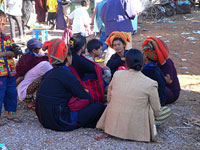 At an altitude of 1400m, the pine-clad hill station of Taunggyi is also a popular summer resort with its scenic charm and pleasantly cool climate. It is not only the capital of southern Shan State but a growing trade centre for the south-western area of Shan State with the goods from Thailand, China and India. The special event of Taunggyi is HOT-AIR or FIRE BALLOON FESTIVAL held around the full-moon day of Tazaungmone, usually coincides with November.
At an altitude of 1400m, the pine-clad hill station of Taunggyi is also a popular summer resort with its scenic charm and pleasantly cool climate. It is not only the capital of southern Shan State but a growing trade centre for the south-western area of Shan State with the goods from Thailand, China and India. The special event of Taunggyi is HOT-AIR or FIRE BALLOON FESTIVAL held around the full-moon day of Tazaungmone, usually coincides with November.
EAST OF MYANMAR
FAR EASTERN SHAN STATE
KYAING TONG (Kengtung)
Shan State has been described as the land of picture postcard setting by many travelers. Holding almost a quarter of Myanmar’s land area, it is often hard to find the exact word to describe to its beautiful scenery. Among the towns in the Shan State, KYAING TONG, 456m north-east of Taunggyi, is probably the most scenic town. Formerly known as Kengtung, it is the capital of the Eastern Shan State and locates at the centre of the world known “GOLDEN TRIANGLE” Region. Beautiful mountains where travelers can visit one-day trekking explorations to the ethnic minority villages of Akha, Lahu, Wa, Shan and other mountains-tribes surround this picturesque town.
TACHILEIK
Tachileilk, about 163km south of Kyaing Tong, is a small town on Thai-Myanmar border. Travelers are generally permitted to cross the bridge over the Mai-Seng creek. There is a busy market full of Myanmar, Thailand, and Chinese goods. For the travelers who want to continue further up to Kyaing Tong should have to get through the necessary formalities.
SOUTHERN STRIP OF MYANMAR
DAWEI (Tavoy)
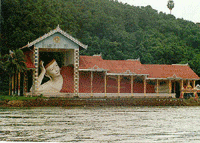 Dawei is a sleepy, seaside town with its considerable importance as a port. It includes in the Tanintharyi Division known to the outside world as Tenasserim which has a long history of trade with India and the Middle East. Dawei is now generally permitted to visit. It is accessible by air and road. The most interesting site of Dawei is 74m long, 21m high huge reclining Buddha located at the edge of town.
Dawei is a sleepy, seaside town with its considerable importance as a port. It includes in the Tanintharyi Division known to the outside world as Tenasserim which has a long history of trade with India and the Middle East. Dawei is now generally permitted to visit. It is accessible by air and road. The most interesting site of Dawei is 74m long, 21m high huge reclining Buddha located at the edge of town.
MYEIK (Mergui)

Myeik, 248km farther south of Dawei, (known as Mergui in colonial times and pronounce as Beik in Myanmar spoken form) perched on a peninsula that just out into the Andaman Sea. Due to its location Myeik has developed as an important port for over 500 years. Rubber, coconuts and marine products are major source of Myeik. Another famous product is the swiftlet bird’s nest very much favoured by Chinese throughout Asia. Among the European traders who settled here in the past, probably the most notorious was Samuel White who threw his weight around as harbormaster of Tenasserim division to rob whatever visiting ships and to tax the locals for every shilling he could squeeze.
MYEIK ARCHIPELAGO
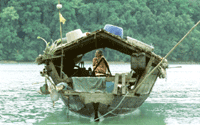 Myeik Archipelago, consists of over 800 islands, is still almost completely untouched as a tourist destination especially for ecotourism. The only inhabitants around the area are Salone or Moken people (nomadic sea gypsies who sail from island to island spending the majority of their year at sea). The islands and surrounding seas are alive with an amazing diversity of flora & fauna and very beautiful underwater scenes including pristine coral reefs and marine life. Mergui Archipelago is probably the one of the most unique destinations left on the planet.
Myeik Archipelago, consists of over 800 islands, is still almost completely untouched as a tourist destination especially for ecotourism. The only inhabitants around the area are Salone or Moken people (nomadic sea gypsies who sail from island to island spending the majority of their year at sea). The islands and surrounding seas are alive with an amazing diversity of flora & fauna and very beautiful underwater scenes including pristine coral reefs and marine life. Mergui Archipelago is probably the one of the most unique destinations left on the planet.
KAWTHAUNG
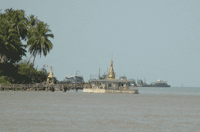 Kawthaung (also spelt Kawthoung) is a small port town at the southernmost trip of Myanmar (about 2000km from the northern trip). It is only separated from Thailand by the Pakchan River. It was known to the colonial British as Victoria Point. It is an important trade town with Thailand and other businesses are fishing, rubber and cashews.
Kawthaung (also spelt Kawthoung) is a small port town at the southernmost trip of Myanmar (about 2000km from the northern trip). It is only separated from Thailand by the Pakchan River. It was known to the colonial British as Victoria Point. It is an important trade town with Thailand and other businesses are fishing, rubber and cashews.
BEACHES OF MYANMAR
NGAPALI
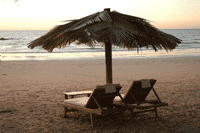 This beach resort is located on the northern coast in Rakkhine State, about 7 km away from THANDWE (SANDOWAY), one of the ancient Rakkhine (formerly ARAKAN) towns. It is said to have been named after the NAPLE of ITALY by a homesick Italian. It is famous for its natural and unspoilt beauty up to this day. The beach stretches about 3 km with soft white sand fringed by coconut palms. It serves as the best ground for sunbathing and recreation such as beach strolling, cycling and so on. Unlike today’s beaches of Asia, it is free of noisy beachside bars, crowded people and hawkers persuading you to buy their things. There are only natural scenic beauty of the blue sea, white sand and the lovely sun. The sea is cobalt blue, without any dangerous marine animals, clean and clear with gentle waves. There is an 18-hole golf course at about 5km from Ngapali Beach Hotel.
This beach resort is located on the northern coast in Rakkhine State, about 7 km away from THANDWE (SANDOWAY), one of the ancient Rakkhine (formerly ARAKAN) towns. It is said to have been named after the NAPLE of ITALY by a homesick Italian. It is famous for its natural and unspoilt beauty up to this day. The beach stretches about 3 km with soft white sand fringed by coconut palms. It serves as the best ground for sunbathing and recreation such as beach strolling, cycling and so on. Unlike today’s beaches of Asia, it is free of noisy beachside bars, crowded people and hawkers persuading you to buy their things. There are only natural scenic beauty of the blue sea, white sand and the lovely sun. The sea is cobalt blue, without any dangerous marine animals, clean and clear with gentle waves. There is an 18-hole golf course at about 5km from Ngapali Beach Hotel.
NGWE SAUNG
 Ngwe Saung lies in the west of Pathein, the capital of Ayeyarwaddy Division .It is a most recently developed beach resort, conveniently located within 5 hours drive from Yangon. One can enjoy the wide range of sports and recreation facilities, health spa, cascading swimming pool and landscaped gardens.
Ngwe Saung lies in the west of Pathein, the capital of Ayeyarwaddy Division .It is a most recently developed beach resort, conveniently located within 5 hours drive from Yangon. One can enjoy the wide range of sports and recreation facilities, health spa, cascading swimming pool and landscaped gardens.
CHAUNG THAR
Chaungtha lies in the south west of Pathein. It is a beautiful beach with silver sands, pristine green sea, flanked by palm trees. Surfing in the sea and riding on the bullock-cart along the beach is an unforgettable experience.
WEST OF MYANMAR
RAKHINE STATE
SITTWAY
RAKHINE (formerly ARAKAN), unspoiled and unexplored, has until recently hidden some of the country’s best-kept secrets. SITTWAY is the capital of Rakhine State and has several interesting Pagodas and a fascinating Monastery on the main street. The abbot and other monks have a wonderful collection of Buddha Images and it is well worth spending some time exploring their “MUSEUM”. Some Images are copies but many are originals dating from the 15th century. Another highlight of SITTWAY is the beach where a promontory makes and ideal place to sit and absorb the sunset. The rock formations around the promontory are interesting and a stunning black sand beach stretches as far as the eye can see. SITTWAY is the gateway to MRAUK U. The 5-hour trip up-river from SITTWAY to MRAUK U affords an insight into life on the river and surrounding countryside.
MRAUK U
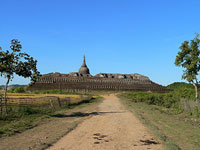 Until lately, it was not so easy to get information about the ancient city MRAUK U and the area was not so accessible. Although it is often recommended to the adventurous travelers, MRAUK U is a growing destination in Myanmar. It has been described as a “Lost City” and the boat trip from archeological site of Wethali, another ancient capital of Rakkhine kingdom dating back to the 4th century.
Until lately, it was not so easy to get information about the ancient city MRAUK U and the area was not so accessible. Although it is often recommended to the adventurous travelers, MRAUK U is a growing destination in Myanmar. It has been described as a “Lost City” and the boat trip from archeological site of Wethali, another ancient capital of Rakkhine kingdom dating back to the 4th century.
Bldg. 18, Flat-5(B), Mahar Zeya Street, Pazutaung Township, Yangon, Republic of the Union of Myanmar.
Tel: + (95 1) 9000 052, + (95 9) 516 4335, + (95 9) 4310 8864, Fax: + (95 1) 294 977, E-mail: melite@ytp.com.mm,


